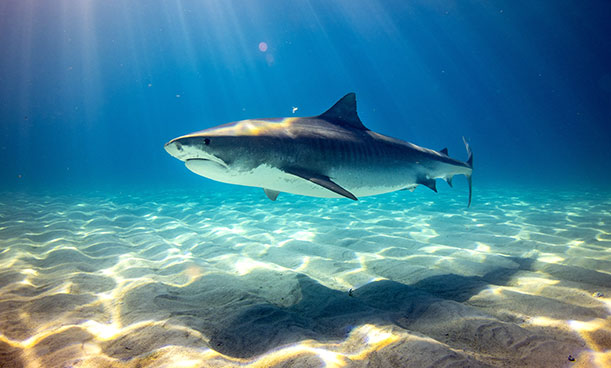BOOMbox at Home: Things That Live in the Water
April 28, 2021

During spring, we're exploring the four elements of earth, air, fire, and water. This week, we’re looking at creatures that live in water.
Sharks
“Be like a shark--just keep moving forward!” You may have heard this motivational message based on the myth that sharks must constantly keep swimming in order to survive. The truth, at least for most sharks, is that it’s safe to rest. However, they do need to keep swimming to control their depth. Unlike most fish, sharks can function at a variety of depths. You may have noticed in movies that sharks seem to be all over the ocean, from a fin peaking through the surface of the water to a predator patrolling the deep. Most fish float using a swim bladder, a gas-filled organ that can inflate or deflate to allow the fish to move up and down. Sharks have a different approach. Oil in their livers helps them stay buoyant while their fins help them control their depth. Because swim bladders are filled with gas, they are strongly affected by changes in pressure. Animals with swim bladders have to stick to specific depth ranges to stay safe. Sharks, on the other hand, can move more freely throughout the ocean.
Learn more about how sharks use their oil-y livers to stay afloat. Then, explore some common misconceptions about sharks from the American Museum of Natural History.
Cephalopods
Cephalopods are marine animals with many arms, or tentacles, like octopi, squids, and cuttlefish. These creatures can have some crazy features. Let’s learn about a few examples.
Guess what squids have in common with rockets? Both use a form of jet propulsion, movement caused by ejecting a liquid or gas in the opposite direction of the movement. This is how squids can rapidly swim backward away from a predator. You can experience jet propulsion in your own bathtub using a water balloon and a recycled bottle top with this fun squid locomotion activity.
Cuttlefish are colorblind, but that doesn’t stop them from being masters at camouflage. Their multilayered skin allows them to change color, pattern, and even texture to blend in with their environment. The top layer of their skin is covered in chromatophores, balloon-like organs containing pigment. Tiny muscle movements allow the cuttlefish to make certain pigments more or less visible on their skin, effectively changing colors. Try your own cephalopod camouflage. Want to dig deeper? Read more about the texture of cuttlefish camouflage and build your own model papilla.
Whales
Underwater environments can have extreme temperatures. The Arctic Ocean is typically around 28℉--below the freezing point of freshwater and just above the freezing point of saltwater. Blubber, a thick layer of fat just under the skin in animals like seals and whales, helps them stay warm in such cold temperatures. To truly appreciate the insulation of blubber, try this handmade blubber science project, and read more about how aquatic animals use blubber and stay warm. Or, learn how to make your own felt whale bookmark.
Microscopic sea life
Blue whales might be the biggest creatures in the ocean, but for dinner they chow down on some of the smallest creatures in the ocean. In a single day, one blue whale can eat up to four metric tons of krill, a type of plankton that looks like a tiny shrimp. Our oceans are full of plankton, tiny creatures that float with the water currents. Some plankton are too small for us to see, but you can watch what plankton look like under a microscope. Because they are so small and they can’t run from predators, plankton sit at the very bottom of the food chain. Try being at the bottom of the marine food chain and work your way up by playing the game deeeep.io.
Scientist of the Week
Eugenie Clark (1922-2015), also known as "the shark lady," was an Asian American ichthyologist who pioneered the use of scuba diving for shark research and cofounded a world-renowned marine lab. Throughout her life, she published 3 books and more than 175 articles. She worked to promote marine conservation and discovered a natural shark repellent to help prevent dangerous encounters between humans and sharks. Five different species of fish have been named after her.
Despite Clark’s great success, female shark scientists, particularly women of color, still face significant barriers to access in the field. In 2020, a group of four Black female scientists created Minorities In Shark Sciences (MISS), an organization to help combat these issues and promote diversity and inclusion.
Written by Eli and Michelle.